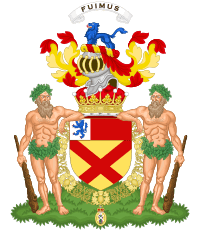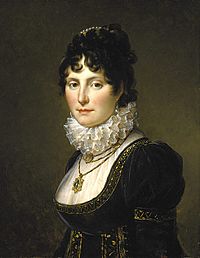Thomas Bruce, 7th Earl of Elgin facts for kids
Quick facts for kids
The Earl of Elgin and Kincardine
FSA Scot
|
|
|---|---|

Thomas Bruce, 7th Earl of Elgin and 11th Earl of Kincardine, by Anton Graff (around 1788).
|
|
| Tenure | 1771–1841 |
| Known for | The controversial procurement of Marble Sculptures from the Parthenon, Acropolis in Greece |
| Born | 20 July 1766 Broomhall, Fife, Scotland |
| Died | 14 November 1841 (aged 75) Paris, France |
| Nationality | British |
| Spouse(s) | Mary Nisbet (m. 1799) Elizabeth Oswald (m. 1810) |
| Issue | 11, including James, Robert, Thomas, and Augusta |
| Parents | Charles Bruce, 5th Earl of Elgin Martha Whyte |
| Signature |  |
Thomas Bruce, 7th Earl of Elgin (born July 20, 1766 – died November 14, 1841), often called Lord Elgin, was a British nobleman, soldier, and diplomat. He is best known for bringing marble sculptures, now called the Elgin Marbles, from the Parthenon in Athens, Greece, to Britain. This act caused a lot of discussion and debate.
Contents
Early Life and Career
Thomas Bruce was born at Broomhall House in Scotland. He was part of the old royal house of Bruce. When he was only five years old, his older brother passed away, and Thomas became the 7th Earl of Elgin.
He went to famous schools like Harrow School and Westminster School. He also studied at the University of St Andrews in Scotland and the University of Paris in France.
In 1785, Elgin joined the army as an ensign in the Scots Guards. Over the years, he moved up in rank. By 1795, he was a major. He later became a colonel in 1802 and a major general in 1809.
From 1790 to 1807, he was a Scottish Representative Peer. This meant he represented Scotland's noble families in the British Parliament.
Diplomatic Missions
Elgin also had an important career as a diplomat. In 1791, he worked as a special envoy in Austria. He then served in Brussels from 1792 until France took control of that area. In 1795, he was sent as an envoy to Prussia.
In December 1798, Lord Elgin was chosen to be the ambassador to the Ottoman Empire. This empire was very powerful and included Greece at the time. He arrived in Constantinople (now Istanbul) in November 1799. His job was to help Britain become more influential during a conflict between the Ottoman Empire and France. He was very skilled in this difficult role.
In March 1799, before he left for Constantinople, Elgin married Mary Nisbet. His time as ambassador ended in January 1803.
The Elgin Marbles
Lord Elgin was very interested in art and ancient history. He talked with a diplomat and archaeologist named Sir William Hamilton. Elgin decided to hire a team of artists and architects. Their job was to make plaster copies and detailed drawings of ancient Greek buildings and sculptures. He hoped this would help British art.
Elgin hired a painter named Lusieri and other skilled artists. They went to Athens in 1800 to draw the ancient monuments. Elgin said that in 1801, he received a special permission document called a firman from the Ottoman government. This document supposedly allowed his team to work on the Parthenon. It also allowed them to "take away any pieces of stone with old inscriptions or figures thereon."
However, there is debate about this document. An Italian translation exists, but the original Turkish copy has not been found in Turkish government records.
At first, Elgin did not plan to remove the actual marble sculptures. But his representative in Athens, Philip Hunt, decided to do so. Elgin's team removed about half of the Parthenon's frieze (a long band of sculpture). They also took fifteen metopes (square panels with carvings) and seventeen pieces from the pedimental sculpture (sculptures from the triangular parts of the roof). They also took a caryatid (a sculpted female figure used as a column) and a column from another building called the Erechtheion.
In 1803, some of the marbles were being shipped to Britain. Elgin's ship, the Mentor, sank near Cerigo. It took three years and a lot of money to get the marbles back from the sea. Even after Elgin left the Ottoman Empire, his team continued to collect more items. By 1812, many more cases of antiquities arrived in England.
Elgin's actions were supported by some people, but others strongly criticized him. The famous poet Lord Byron was one of those who thought it was wrong. He wrote poems saying that the marbles should have stayed in Greece.
Elgin defended his actions in a pamphlet published in 1810. He argued that he was saving the marbles from damage. In 1816, the British government bought the marbles from Elgin for £35,000. This was much less than he had spent. The marbles were then given to the British Museum, where they have been on display since 1817.
Today, Greece believes the Elgin Marbles should be returned to their home country. Discussions between British and Greek officials about their future are still happening.
Detention in France
After leaving Constantinople, Lord Elgin and his family planned to travel back to Britain through Italy and France. But in May 1803, war started again between Britain and France. They were in Lyon, France, when this happened. Elgin was made a prisoner of war. He was released on the condition that he would not leave France.
Later, he was held in a fortress. The French offered to release him in exchange for a French general held in England, but Britain refused. Elgin was eventually allowed to leave France in June 1806. This happened after a direct request from the British Prime Minister to Napoleon.
Return to Britain and Later Life
When Lord Elgin returned to Britain, his first marriage ended. This caused some public discussion at the time.
In 1807, he lost his seat in the House of Lords. Because of the conditions of his release from France, he could not return to a military or diplomatic job. Elgin was also in a lot of debt because of his time as ambassador and the costs of collecting the marbles. He mostly stayed out of public life after this.
In September 1810, Elgin married Elizabeth Oswald. That same year, he tried to sell his collection of antiquities to the government. But he withdrew his offer when they only offered him £30,000.
In 1820, Elgin was again elected to the House of Lords. However, his requests to be given a higher noble title were not successful. To escape his debts, he eventually moved to France. He passed away in Paris on November 14, 1841.
Family
Lord Elgin was married two times.
On March 11, 1799, he married Mary. She was the only child of William Hamilton Nisbet. They had one son and three daughters:
- George Charles Constantine, Lord Bruce (1800–1840)
- Lady Mary (died 1883)
- Lady Matilda Harriet (died 1857)
- Lady Lucy (1806–1881)
After his first marriage ended, Elgin married Elizabeth Oswald on September 21, 1810. They had four sons and three daughters:
- James Bruce, who became a governor in British North America and India.
- Robert Bruce (1813–1862), a military officer.
- Sir Frederick Wright-Bruce (1814–1867), a lawyer and diplomat.
- Thomas Charles Bruce (1825–1890), who became a Member of Parliament.
- Lady Charlotte-Christian (died 1872)
- Lady Augusta Frederica Elizabeth (died 1876), who worked for Queen Victoria.
- Lady Frances Anne (died 1894)
See also



